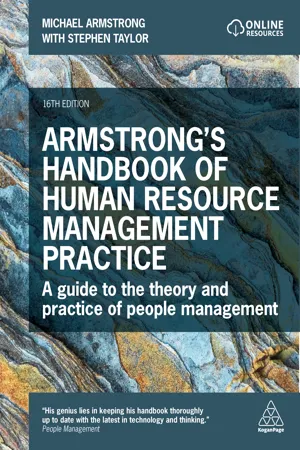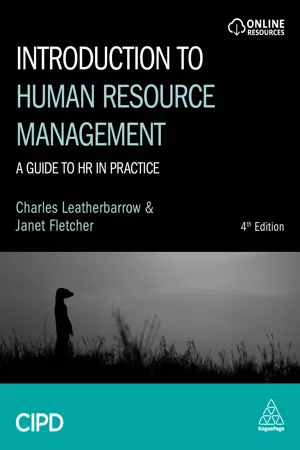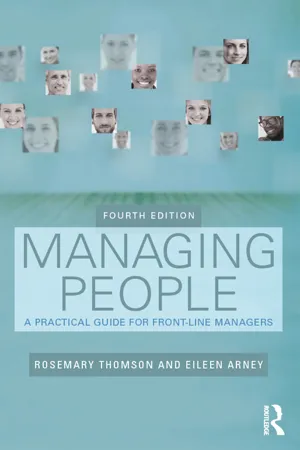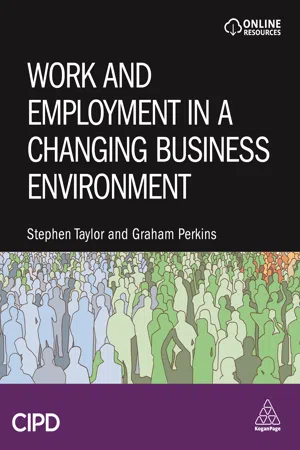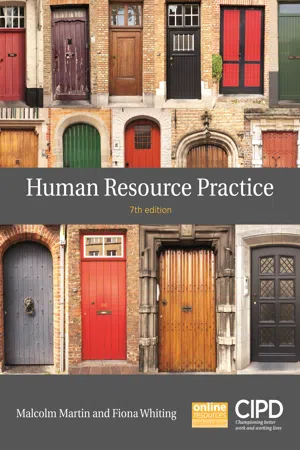Business
Employment Law
Employment law encompasses the legal framework governing the relationship between employers and employees. It covers areas such as hiring, wages, working conditions, discrimination, and termination. Compliance with employment law is crucial for businesses to ensure fair treatment of employees and avoid legal disputes.
Written by Perlego with AI-assistance
Related key terms
Related key terms
1 of 4
Related key terms
1 of 3
8 Key excerpts on "Employment Law"
- eBook - ePub
Armstrong's Handbook of Human Resource Management Practice
A Guide to the Theory and Practice of People Management
- Michael Armstrong, Stephen Taylor(Authors)
- 2023(Publication Date)
- Kogan Page(Publisher)
60Dealing with the legal aspects of employment
Introduction
Dealing with the legal aspects of employment means ensuring that the organization complies with the legal requirements affecting employment and that any legal issues that arise are dealt with satisfactorily. It is a typical and demanding part of the role of HR professionals who handle matters affecting the employment relationship and how employees behave and are treated at work. To carry it out they have to understand the main provisions of Employment Law, ensure compliance with its requirements and deal with Employment Law issues. These areas of responsibility are examined in turn in this chapter.Employment Law provisions
The employment relationship is subject to a great deal of regulation in all industrialized counties and is increasingly a feature of HRM practice in developing economies too. While the details and extent of regulatory protection vary from country to country as well as the enforcement mechanisms, the aims of employment legislation are remarkably similar (Ashiagbor, 2005; Slattery and Broadbent, 2013). It is also the case that in all countries the trend in recent years has been towards greater levels of employment regulation, not least due to the actions of supra-national bodies such as the International Labour Organization (ILO) and the European Union (EU) which have persistently promoted higher standards of employment practice underpinned by law.For employers in the UK the adjustment required by the introduction of extensive Employment Law has often been problematic as the UK’s labour market was historically one of the least regulated in the world. There thus remains a strong tendency for employers and their representatives to resist the introduction of new regulation and to campaign for a reduction in the existing ‘regulatory burden’ on the grounds that it both deters organizations from taking new staff on, while also making the UK economy as a whole less globally competitive than it would otherwise be. Despite these misgivings, it is clear that Employment Law is here to stay and that it makes good business sense to comply with its requirements. Most employers have to face employment tribunal claims from time to time and most HR professionals have to deal with their consequences on a fairly regular basis. - eBook - ePub
- Robert B. Mellor(Author)
- 2019(Publication Date)
- Emerald Publishing Limited(Publisher)
Chapter 9HR Theory and Employment Law
Ken MorrisonWhat We Will Learn
Benjamin Franklin famously exclaimed that nothing is certain, except death and taxes. Another certainty is that most of humanity will either be employers or employees for much of their adult lives. It is one of the most fundamental experiences giving meaning to our time on Earth. Thus, it is important to have some understanding of the law around people management, which is variously referred to as Employment Law, labour law or HR law.The information set out below is generic and absolutely no substitute for professional legal advice from a lawyer specialising in Employment Law, who can advise you on details of your specific circumstances.The information here is correct as of April 2018 but law is in a state of continuous judicial development as thousands of cases are heard annually and any case may influence the way a court or tribunal interprets future cases.This chapter explores the lifecycle of employment, from start to finish, looking at the role of statutory rights and the impact of European Union directives and anti-discrimination laws on people management across the employment spectrum.By the end of this chapter you should understand the basis on which the employment relationship is regulated and an appreciation for the complexity of managing staff.Employment and the Law
Law is the clearest expression of national ethics and societal norms and here we look at values in the employment sphere from an English law standpoint. Britain is an influential legal regime which directly impacts many countries previously ruled by Britain. Modern UK Employment Law is liberally seasoned with EU-derived law and so shares many characteristics of other European Employment Law regimes, particularly (but not solely) about non-discrimination. - eBook - ePub
Introduction to Human Resource Management
A Guide to HR in Practice
- Charles Leatherbarrow, Janet Fletcher(Authors)
- 2018(Publication Date)
- CIPD - Kogan Page(Publisher)
16Employment Law
This chapter is a guide to Employment Law and is not a replacement for taking sound legal advice.After studying this chapter, you should:LEARNING OBJECTIVES
- be able to find Employment Law legislation using: http://www.legislation.gov.uk/
- be able to define the employment relationship and understand its legal framework;
- understand the contract of employment and the main statutory provisions that contribute to its regulation;
- understand the contractual and statutory rights of employees;
- understand the fundamentals of UK: equal pay, family-friendly, disciplinary, grievance, health-and-safety legislation, data protection and freedom of information legislation;
- be able to define the role of the Information Commissioner in the context of the General Data Protection Regulations (New Data Protection Act, 2018) and the Freedom of Information Act (2000);
- understand the differences between the GDPR, which replaces the (1998) Data Protection Act, and the Freedom of Information Act (2000).
The employment relationship and legislation
The UK’s employment legislation sets the formal framework within which the employer and an employee conduct their business. Employment legislation sets responsibilities for both the employer and the employee and gives rights to the employee in the context of the employment relationship.Differences between contracts
As mentioned in Chapter 13 , ‘The employment relationship’, there is a contract of employment between the employee and employer. The employment contract can be of defined duration or be continuous (permanent). Whether the relationship is of a defined duration or continuous, the legal statutes govern the actions of both employer and employee.All employees have a contract of employment. It is based on what both parties have agreed to be a fair exchange, the employee’s time and skill in exchange for a salary or wage. It is different from a commercial contract, such as, for example, the sale and purchase of a car or house. Such contracts have completion dates, terms, and conditions that are an integral part of the agreement. Unless the duration is specified at the outset, an employment contract is of continuous duration, in that both parties intend that it should go on until one of the parties to the contract wishes to terminate the relationship. - eBook - ePub
- Nikki Booth, Clare Robson, Jacqui Welham, Alison Barnard, Nicki Bartlett(Authors)
- 2009(Publication Date)
- Routledge(Publisher)
2 Legislation, Regulation and the Employer 2.1 Introduction This chapter intends to highlight the employment regulations that protect the groups of employees set out in C HAPTER 1. In some cases the employees will receive nothing more than the basic protection, whereas others will be covered by a wide variety of regulations. This chapter will attempt to highlight any loopholes in the current regulations and whether they favour the employee or the employer as the relevant regulations are dealt with. A Human Resources Manager should be aware of the regulations which govern all employees, even if only as an overview. Obviously, the larger the employer the more likely the Human Resources Manager will come across a wider spectrum of diversity. However, all should make themselves aware of the regulations, as they can apply from the initial stages of recruitment through to post-termination references. It should be noted that some of the regulations mentioned in this chapter are relatively new and have not yet been challenged or tested in the tribunal system. Over the next two years claims relating to the rights brought about by the Employment Act 2002 should be monitored carefully particularly in relation to flexible working and discrimination on the grounds of sexual orientation and religion. This chapter is intended to be a rough guide for Human Resources Managers in how to deal with employees, from in house issues and problems through to dismissal. Employment Law protection 2.2 How are these diverse employees protected under Employment Law? There are two main pieces of legislation that apply to all employees irrespective of their diversity. These are the Working Time Regulations 1998 (SI 1998/1833) and the Employment Rights Act 1996. The former applies to all workers and is not just restricted to employees. Therefore where Employment Law did not make, for example, lone and home workers diverse, it does afford them some protection under these regulations - eBook - ePub
Managing People
A Practical Guide for Front-line Managers
- Rosemary Thomson, Eileen Arney, Andrew Thomson(Authors)
- 2015(Publication Date)
- Routledge(Publisher)
9 The regulation of behaviour at work IntroductionIn this chapter we deal with the implications for managing people of the legal system and the institutions that complement it. Over the last 50 years Employment Law has become one of the most complex and regularly modified parts of the legal system, and also one of the most politically contentious, because law is an important source of power in the employment relationship. Managers not infrequently have to face situations which could have legal consequences; most of course do not result in any drastic development, which is just as well if work is to have continuity and stability, but managers need to be aware of what might be involved in a given situation. It cannot be overstated that the best way of avoiding any problem is for managers themselves to be aware of the principles of the law, if not the details. At the organisational level there are likely to be rules that will have legal consequences and managers need to be aware of the implications of these.Many larger organisations employ specialist staff to deal with personnel-related matters and it is their responsibility to keep up to date with the many and frequent changes in the law. This is quite a daunting task even for experts. However, even in organisations with this facility, the front-line manager is likely to be the initial person involved in any formal grievance or disciplinary matters. On a day-to-day basis, you may have to deal with the first signs of trouble and, if there is no handy personnel department, with subsequent action. In many cases, it is the front-line manager’s responsibility to deal with cases of grievance or to become involved in disciplinary action when this becomes inevitable; it is also his or her responsibility to offer help and advice to staff who have work-related problems and, where necessary, to recommend that they seek professional advice, possibly from the Advisory, Conciliation and Arbitration Service (Acas). - Stephen Taylor, Graham Perkins(Authors)
- 2021(Publication Date)
- CIPD - Kogan Page(Publisher)
10Employment regulation
At the start of Chapter 9 we explained that one of the jobs of government is to propose new legislation and to pilot it successfully through Parliament. It is through this process that most Employment Law is made and methods for its enforcement set. This is not, however, the only mechanism. Much UK Employment Law has a European origin and would in all likelihood not be on the UK statute book had it not been for the forty-six years that the UK was an EU member state. These regulations are found in UK statutes but do not originate with the UK government. Moreover, we also have a great deal of common law which helps to determine what happens in employing organisations and provides a legal forum in which disputes between employers and employees can be argued out and settled. Common law is made by judges rather than parliamentarians, and it has been evolving steadily as cases are brought to court and considered over several centuries.In this chapter we introduce all the major elements of UK Employment Law. You will see that these have a major influence over a very wide range of people management activities, including recruitment, promotion, terms and conditions, pay, health and safety, holiday entitlement, family leave rights and, of course, dismissal.We will go on to explore some of the major debates that exist in respect of employment regulation, thinking about how far it achieves a fair balance between the interests of employees and their employers.The development of employment regulation in the UK
In recent years, the volume and complexity of employment regulation has grown very significantly. The UK workplace and labour market are now some of the most heavily regulated in the world, yet this was very much not the case until relatively recently.- eBook - ePub
- Glynis D Morris, Sonia McKay, Andrea Oates(Authors)
- 2009(Publication Date)
- CIMA Publishing(Publisher)
Chapter 10. Employment Law10.1. Types of Worker
The legal responsibilities which an employer has to an individual depend on the nature of the employment relationship. An individual may be working:At a Glance
■ Workers are self-employed where they provide their own tools and equipment, take a degree of financial risk, can profit from their own work management and control their own work.■ The standard test used to establish whether someone is an employee is whether their work is normally directed and under a real element of control by their employer and there are mutual obligations to provide and perform work.■ Employees on temporary or fixed-term contracts have the right to be treated no less favourably than permanent workers. ■ Employers are required to take particular account of young people’s experiences and assess any specific risks related to inexperience in determining the work they are required to do. ■ There is a general duty of care to the employee in relation to homeworking contracts.■ Whether workers are full-time or part-time does not affect their statutory employment rights; however, there is a legal duty on employers to ensure that part-time workers are treated no less favourably.■ under a contract of service (employment) – directly employed by the employer – in legal terms defined as an ‘employee’;■ under a contract for services – working for an employer but not directed by the employer and able to arrange for substitutes – in legal terms usually defined as a ‘worker’ or■ under a contractual relationship of self-employment – working for another party but taking their own financial risks, providing their own tools and so forth.An employee, working under a contract of employment, has legal rights which extend beyond those applicable to those working under a contract for services. Additionally, employment rights may depend on the status of the employee, whether permanent or temporary, a young worker, teleworker or homeworker. - eBook - ePub
- Malcolm Martin, Fiona Whiting(Authors)
- 2016(Publication Date)
- CIPD - Kogan Page(Publisher)
So despite the differences explained here, it is very important to realise that the distinction is not always clear-cut and that you may need to seek advice. Courts and tribunals can come to differing conclusions on seemingly similar situations and are not bound by decisions made by other bodies such as HMRC. You will find frequently asked questions on employment status under that heading on the CIPD website and further guidance in a reference under Further Reading at the end of this chapter. Remember that if a contract of employment is made, a statement of written particulars should be provided within two months.REFLECTIVE ACTIVITY 3.6
Consider the people who help accomplish your organisation’s objectives. Are they all employees? If not, how would you categorise them? Carry out some appropriate research into the nature of their relationship with the HR function. For example, you might want to investigate what records are kept for them and what employment rights they have, and reflect on how the responsibilities of the HR department differ for these people and your employees. Discuss the issues with your learning sources.3.5 DURING EMPLOYMENT – RIGHTS AND RESPONSIBILITIES
We could probably devote a whole book to the employment legislation that is relevant during the employment relationship. As this section is only part of one chapter, we will necessarily be taking a broad overview of the relevant legislation and will focus on the key individual rights that an employee has under the law during the employment relationship.3.5.1 DISCRIMINATION AND EQUALITY RIGHTS
Here we shall be looking at a wide range of areas of potential discrimination; first we examine some broad principles.Although it may be argued that it makes sound business sense to recruit people solely on their ability to do the job, that judgement is easily influenced by beliefs that are not relevant or by conscious or unconscious bias. Even those committed to recruiting on ability can find themselves victims to prejudice that they did not realise they had. More disturbingly, there are still managers who will admit, privately, to unlawful discrimination. For example, they may have prejudices about women who ‘might go off on maternity leave’ or feel unable to relate to people of a different culture from their own. Unfortunately, in bringing such prejudices to the workplace, they mistakenly believe they serve themselves and their employer better because of it.
Index pages curate the most relevant extracts from our library of academic textbooks. They’ve been created using an in-house natural language model (NLM), each adding context and meaning to key research topics.
Explore more topic indexes
Explore more topic indexes
1 of 6
Explore more topic indexes
1 of 4
